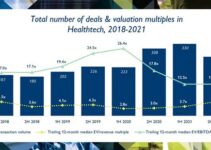Clayton Dubilier & Rice’s recent marriage of Vera Whole Health and Castlight Health reflects the emergence of M&A that unites traditional care delivery with health tech companies and cultures.
Why it matters: CD&R partner Ravi Sachdev tells Sarah that there’s a growing recognition that traditional benefit management models don’t work without deep engagement from the provider.
- That’s fueling this M&A strategy, and driving the progression of value-based care adoption across new targeted populations beyond primary care for seniors.
- “Everybody who is creating a business today is really thinking about how they get the provider more integrated versus just being the service layer,” Sachdev says. “And for a long time, all you had to do was just create the service layer.”
- “To be sustainable and to be able to get traction, a lot of the technology companies are realizing they can’t go at it alone now, which is a very different change in attitude,” adds Sandi Peterson, CD&R operating partner.
- Another great example: is the three-way merger of Fresenius Health Partners, InterWell Health and Cricket Health aimed to disrupt kidney care.
Zoom in: Vera-Castlight marks CD&R’s fourth iteration of value-based care, following investments in naviHealth (now an Optum business), agilon health and Millennium Physician Group.
- Sachdev this time around says the aim is to redesign the under-65 pocket of employer-sponsored primary care in a way “that hasn’t really existed before.”
- “When we started in Medicare, while we were bringing a global risk model, people understood capitation,” Sachdev says. “Here, we’re actually trying to invent the payment model too.”
- Vera’s partnerships with Anthem and JPMorgan Chase make that possible, he says.
- So is the digital health tech that Castlight brings. Connecting directly to a provider for the first time, Castlight can support Vera’s doctors by equipping them with tools to engage with patients more effectively.
Between the lines: After UnitedHealth’s Optum and Humana, Sachdev says that CD&R is “probably the biggest primary care lives aggregator in the country in risk.” That he thinks will give CD&R continued differentiation.
- “Capabilities that we could leverage across our ecosystem is something we’re going to think about and the home could be an interesting part of that,” Sachdev says.
Yes, and: This fusion of tech and health care services has culture implications.
- “As we’ve really switched to people recognizing that there’s a lot of value in outcome versus just more utilization, that’s why you see this merging happening of technology and care delivery,” Sachdev says.
- That’s a big culture change for tech companies, which he says have historically focused on selling a product versus being an input to how you create outcome.
Separately, CD&R is participating in the convergence of health care and Big Tech as it relates to pharma services, Peterson says.
- Peterson points to M2GEN, an oncology data and informatics company that recently partnered with Microsoft to build up a more robust tech stack.
- CD&R didn’t participate in the first wave of CROS, but on the pharma side, “we’re still in the early stages of getting smarter about the body, and a lot of things are enabled by tech,” Peterson says.
What’s next: As the health and tech worlds keep colliding, so will the types of firms working together.
- Sachdev suspects CD&R and other large funds will keep mining for value creation opportunities down market, while smaller funds (like Oak HC/FT) play in other (larger) segments of the market.
- “I think that people are going to start to attack the innovation opportunity beyond venture capital in a pretty meaningful way.”


